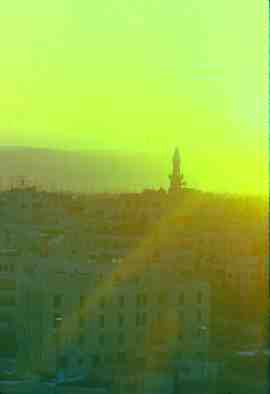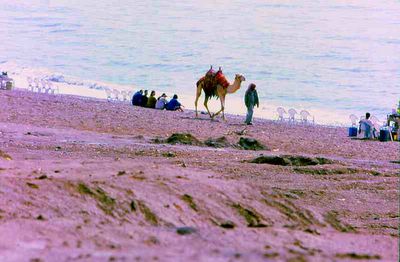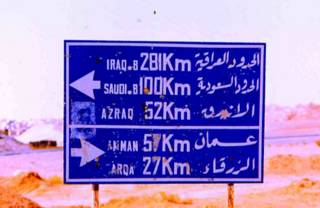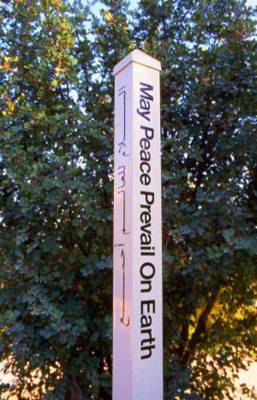
Madaba,
Jordan sits some 40 minutes south of Amman, the capital. I'd spent several hours sightseeing in and around Amman and found myself, at 2:30 in the afternoon, with hours of daylight and a half-tank of gas left, so I steered the rental car onto the
King's Highway, a desert road that follows the meanders of a 5,000-year-old route mentioned in the book of Genesis, and headed for
Madaba, "City of Mosaics."
I found the Madaba exit, drove uphill into the town and popped in on the small Church of the Apostles, where I took in its interesting mosaic floor. But I'd really come for Madaba's mosaical piece de resistance, the 6th-century tile floor map of the Holy Land that sits inside the Church of St. George. The mosaic map, which dates from the reign of the
Byzantine emperor Justinian, is the oldest map of the Holy Land in existence and was discovered during construction of the simple, plain-faced 19th-century church.
The Apostles attendant told me to head back downhill to King's Highway then to circle back uphill at the busy intersection where Madaba's main street met the larger road.
Down I went and found the intersection. As in nearly all the Jordanian villages I drove through, the roadside was a place of enterprise and industry, commerce and conversation. A drive through a village center yields a pageant of people shopping, working, walking, waiting for buses, swinging book bags, digging dirt, herding sheep, tending goats, selling fruit, slicing sheet metal, fixing mufflers, driving tractors. Everyone -- merchants, schoolkids, mothers with toddlers, old men in plastic chairs smoking and rubbing strands of prayer beads -- is in the street.
I wasn't surprised, then, when I stopped at the intersection's traffic light and a gorgeous boy with chocolate eyes and teeth like pearls stuck his head and a box of tissues into my open passenger-side window and said, "Kleenex, lady?" I laughed, said thanks but no, and turned the car uphill when the light turned green. The boy and I waved as I drove up into town.
The Church of St. George, so very easy to find according to both the Apostles attendant and my guidebook, eluded me.
In retrospect, considering the artistic and archaeological wonder it held inside, I know I was looking for a building considerably more elaborate than the unassuming little church turned out to be, so I drove right by it. Three times.

After each failed circuit through
Madaba, I'd end up back at the intersection with the traffic light, and each time, the beautiful, laughing boy would see me coming, wave, then stick his head inside the car when I came to a stop. Each time he tried to sell me something.
For a few passes, he stuck to Kleenex: "Hello, lady! Tissue, lady?" On the third pass, sensing a market need that he could fill --
Why, this tourist lady is looking for the mosaic map, and she can't find it, so she needs a guide (a valid conclusion under the circumstances) -- he asked if he could get in the car and help me find
Karak, the walled city crowned by a massive 12th-century Crusader fortress. Karak, which rises 1,000 feet above the desert floor, loomed outside my windshield, just down the road from my Madaba intersection. It was hard to miss, so I declined the offer.
After three attempts, I found the Church of St. George and the mosaic map, a masterpiece. I joined a German tour group that crowded around the 35- by 15-foot wonder. The thousands of 1,500-year-old, still-vivid tiles formed a breathtaking cartographic view of the lands of the Bible, stretching from Jerusalem and the Dead Sea to the Nile Delta. Jerusalem was the map's focal point, and features like the city walls and Damascus Gate were disarmingly detailed and recognizable.
I left the church and drove back downhill for the last time, thinking of the glorious bits of ocher and blue and white polished stone I'd just beheld. I came one last time to the intersection and the boy with the gleaming smile. "I found the map," I told him. "Beautiful. And now, I'll go to Karak."

My friend smiled a smile nearly as big as the mosaic map, shook his head in approval, and said, "Goodbye, lady!"
For current information about Jordan visit the U.S. State Department's travel site or the Jordanian embassy's U.S. office site.www.LoriHein.com


 "So, if you'd gone on your Egypt trip where would you be today?" asked Linda in my yoga class.
"So, if you'd gone on your Egypt trip where would you be today?" asked Linda in my yoga class.












